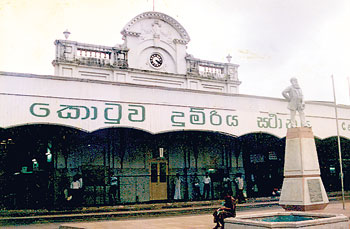Naming of roads in the city of Colombo in the
colonial era was done to commemorate a
personality or a place in their native land or even trees and flowers. In the early days the number of roads was very few but as the numbers increased, naming of roads and streets was not an easy task. Today the city has over a thousand streets.
While some old names still continue, many have changed over the years, particularly because it was felt that the roads should be given names with a local flavour. Among the names still being used from the Portuguese times in the 16th century are San Sebastian Hill and
St. James' Road named after saints. Some have been changed to give a local touch like Grandpass (from Grande Passo) or Main Street (Roa Direto).
The Dutch remembered one of their governors – Hulft who died during the siege of Colombo, with Hulftsdorp and recalled some of their native place names like Leyden and Delft. The Dutch named Maliban Street to identify the fashionable promenade in Pettah – Maliban
meaning the Mall; Kayman's Gate refers to 'kayman' – crocodiles who were found in the area where the rivulet entered the sea; Wolvendaal meant the dale of wolves; Bloemendahl is a vale of flowers; Korteboam means short trees;
The British named roads after their monarchs and famous persons. Every British Governor, except the last three, who
administered the
country was
commemorated with a street name. Since the practice had stopped during the Second World War, no roads were named after Sir Andrew Caldecott, Sir Henry Monk Mason Moore and Lord Soulbury.
 |
| Statue of Colonel Olcott in Pettah |
As the years went by after Independence, there was a clamour for the change of names to remember
patriots and national
leaders. For example, what was Turret Road is today Srimath Anagarika Dharmapala Mawatha. Flower Road is Sir Ernest de Silva Mawatha. Roads and streets have been named after prime
ministers, city councillors, mayors and other persons.
Forty four years ago, on August 16, 1965, a
prominent street in Pettah – Norris Road was named Olcott Mawatha to
commemorate a great leader who helped in the resurgence of Buddhism.
Colonel Henry Steele Olcott was an American theosophist, author,
attorney and philosopher. He was the co-founder of the Theosophical Society in New York in 1875 and formed the Buddhist Theosophical Society (BTS) after coming here. The headquarters of BTS was housed in Norris Road. After re-naming the road, a statue of Colonel Olcott was built at a prominent place – opposite the Fort railway station where
thousands of commuters pass through, throughout the day.
Colonel Olcott was the founder of Ananda College where he is remembered every year when old Anandians gather and
listen to an oration by an old boy of the school on a
contemporary topic.
While in America, Olcott was inspired by a report he read about the famous Panadura debate ('Panadura Vadaya') by Ven. Migettuwatte Gunananda Thera which gave him an insight to the truth he was searching for from a long time. Having made an extensive study of Buddhism, he came to Sri Lanka on May 17, 1880, with a few others including Madame Helena Petrovna nee Hahn Blavatsky, who along with Col. Olcott
founded the Theosophical Society. The two of them became Buddhists at the Vijayananda Pirivena at Weliwatta in Galle.
Colonel Olcott soon realised the sad plight of the Sinhala Buddhists in the country through his
association with
intellectuals such as Ven. Hikkaduwe Sri Sumangala Nayake Thera, Ven. Migettuwatte Gunananda Thera and Ven. Waskaduwe Sri Subhuthi Maha Thera.
On June 17, 1880, Olcott established the Buddhist Theosophical Society for the purpose of giving English
education, a
privilege exclusively enjoyed by Christian children attending Missionary schools. On May 31, 1891, the Maha Bodhi Society was established in India and he was
elected as the Chief Adviser and Director.
He purchased a plot of land with a building at Maliban Street in Pettah, where the Colombo Buddhist Theosophical Society office was
established and
subsequently, used the same building where an English school was
established with 37
children.
An English national,
W. Leadbeater was
appointed as the Principal of this school. He provided education free of charge until 1889. Thereafter, A. E. Bultjens was appointed as the Principal and when the number of children increased, the school was shifted to Maradana, the present day Ananda College. This became one of the foremost colleges in Sri Lanka, with its beginnings at a small hall in Pettah.
He campaigned
successfully to get Vesak Poya declared a government holiday and promoted the designing of a Buddhist flag to obtain a clear identity for the Buddhists.
A stamp was issued on December 9, 1967 in
honour of Col. Olcott to mark the 60th anniversary of his passing away. |

